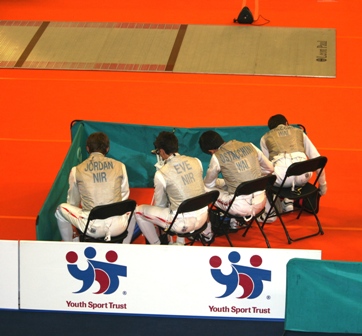
School sport: getting over a barrier with more in the offing
Telling it straight: one future for sport in schools
Sixteen months on from the comprehensive spending review (CSR) and Michael Gove’s attempts to eviscerate sport in schools The Leisure Review went to Yorkshire to meet two beacons of hope in the post-apocalypse landscape.

School sport: getting over a barrier with more in the offing
2012 might turn out to be a year of unprecedented sporting success but it has already shown signs of spawning an equal amount of sport-related rancour. Early into the lists was Baroness Sue Campbell with a new year interview for the Guardian newspaper in which she lambasted the government’s bigoted myopia where school sport is concerned. Arguing against the Tory focus on competition, she made the case for developing physical literacy. It is a tried and tested argument and the fact that Campbell has had to make it again speaks volumes about the retrogressive nature of Gove’s politically motivated cuts.
The latest data from the Youth Sport Trust suggests that some 50% of school sports partnerships have managed to ride out the maelstrom that Gove initiated by stamping his little foot. There are a variety of models being used depending on the political will of their host authority, the attitude of local head teachers and the ambition and approach of whoever was sitting in the partnership development manager’s (PDM) chair when the music stopped. In two Yorkshire partnerships, Legacy Sport from Huddersfield and Active Fusion in Doncaster, the incumbent PDM was a person of vision and passion with the will to innovate and persist. We met them both for coffee and a chat about what they see as the future for sport in schools.
Shaun Fox was a teacher: he isn’t now. As Secretary Gove’s writing was being drafted before being painted on the wall, Fox had already started to take local action. As had Lindsy Gray, who represents the other half of the PDM constituency, having previously made her way in community sports development. Both are now hybrid managers, having added business development, marketing and political negotiation to their portfolio of skills. The change in the accent of their work excites them but both realise that survival depends on their flexibility. “Our strapline is ‘a sustainable sporting future’,” says Fox, “and to be able to deliver that I have had to do a lot of business training. I didn’t do any as a PDM and perhaps I should have.” He cites Businesslink as a source of support and training, together with a company called GB Sport, and speaks about the range of skills he and his team have had to acquire in marketing and business administration.
Picking up the theme, Gray notes: “In the last 12 months the skillsets of PDMs that are still in place have really had to develop. It’s been crazy, a real challenge albeit very interesting. We have had to strip it back, ask what it is schools really want and what we need to market to them. For me it’s been about creating a business hub but one that has the heart and the passion that we are still about. It’s not about money but you do need the money if it’s still going to happen.”
For Gray the change in approach has created “almost a moral dilemma”. She is adamant that her organisation still retains its altruism and its focus on young people but recognises that this can only be delivered if she accepts the commercial imperative to deliver profitable programmes. Fox, by dint of having set up Legacy Sport as a community interest company (CIC) rather than part of a school trust like Active Fusion, is further down the commercial line. “Profit is not a dirty word,” he says, “but if we do make a profit it’s reinvested to allow us to deliver programmes that were previously unsustainable.”
As the discussion turned to contracts of employment, charitable status and redundancy law the concern is that sport is losing out to business in the new landscape and that quality physical education, the fundamental concern of the Youth Sport Trust (YST), has receded as a target. Given that both of the new entities still receive some YST funding, how do these two frontline managers view “the Trust”.
Gray is part of what they now call their ‘national faculty team’. They have lost a lot of staff and so have trained up people to deliver their training courses who they buy in when needed on programmes funded by a diverse collection of funders, including the Health Lottery Fund and Matalan. Fox in contrast is employed for half the week as a school games organiser and has to keep his two roles separate. In one he delivers a national programme designed to meet a politician’s targets; in the other he is “asking teachers what they want and delivering bespoke packages to meet their needs”.
Fox is committed to servicing local demand but conscious that national funding is available: “Jeremy Hunt has just announced a focus on the 14- to 25-year old age group and Sport England, who were working on adult participation, are now shifting their attention so that NGBs are going to have to invest in that new age group.” As commercial operators both Fox and Gray can see that their focus will also be affected but Gray voices a feeling common among sports development managers: “I find it really frustrating to be honest. I know there is a drop-off in participation at that age but if you don’t get it right back at the foundation level people are never going to get sporty. If they have a negative experience at primary school forget it at secondary school and certainly beyond there.” She expands on where her vexation is rooted: “I feel that someone has picked up a load of results and said, ‘That’s where the drop-off is, therefore that’s where the problem is.’ They haven’t unpicked it or wanted to understand the reasons for it.”
If there is confusion thinking in Whitehall it is nothing to the confusion in the minds of people in primary and even secondary schools about who is available to deliver physical activity and what structures exist. As anecdotes are swapped about the proliferation of coaching “one man bands” and the ethics behind some of them, the depth of commitment to the young people at the heart of both organisations becomes clear. The talk is of professional development of coaches, healthy relationships and investment in both the coaches and the young people.
Legacy Sport only use their own full-time coaches, are trained above and beyond NGB requirements and “who broach that gap between the coach and the teacher”. Gray makes a key point when distancing her coaches from companies that charge schools £25 per hour while putting in Level 1 coaches who are paid less than £10 per hour. “Our staff are our USP – the leading edge of the company – and we too have fewer but full-time coaches.” Taking this approach can compromise flexibility as, to use Fox’s expression, neither organisation can “whistle up a handball coach at short notice” but the quality of their delivery is guaranteed and replicable.
Asked to consider the future – theirs, their organisation’s and their sector’s – neither one appears certain. Fox speaks for them both when he says, “We’re not over all the barriers. We’re just over one major barrier and looking down the line to more challenges.” Both are keenly aware that to survive, to be truly sustainable, they must consistently make their case. Having had the privilege to listen while they did just that, The Leisure Review can only hope, for the sake of young people now and in the future, that they manage to continue doing so.
The Leisure Review, March 2012
© Copyright of all material on this site is retained by The Leisure Review or the individual contributors where stated. Contact The Leisure Review for details.
Download a pdf version of this article for printing

Shaun Fox

Lindsy Gray